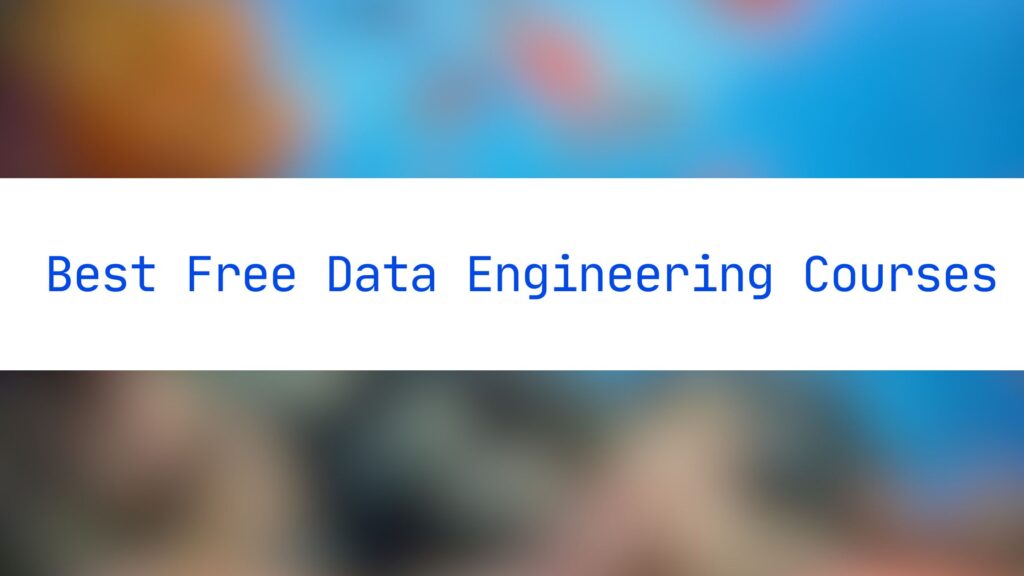If you’ve been trying to learn data engineering, you’re in the right place. I’ve created this post to help you find the Best Free Data Engineering Courses that you can start right away.
I’ve been learning and sharing about data science and machine learning for a few years now. Right now, I’m doing research on how machine learning can help detect depression through social media. So I truly understand how important it is to learn the basics of data engineering, because without it, nothing really works in the data world.
That’s why I’ve picked out 7 great free courses that explain the tools, skills, and day-to-day work of a real data engineer — and yes, they’re all completely free!
So, without any further ado, let’s get started and find the Best Free Data Engineering Courses–
Best Free Data Engineering Courses
- 1. Introduction to Data Engineering
- 2. Data Engineering on AWS – Foundations
- 3. Introduction to Modern Data Engineering with Snowflake
- 4. Introduction to Data Engineering (Intermediate)
- 5. Data Engineering: Pipelines, ETL, Hadoop
- 6. Advanced Data Engineering
- 7. Advanced Data Modeling by Meta
- Final Thoughts from Me
1. Introduction to Data Engineering
Level: Beginner
Time to complete: Around 10 hours
If you’re just getting started and want to understand what data engineering is, this course is a really good starting point.
You’ll get to learn things like:
- What data pipelines are and how they actually work
- The difference between relational databases and NoSQL
- A basic intro to Apache Spark, data lakes, and more
- How to set up a database and run SQL queries
- Why data governance and security really matter
How to take it for free:
Just click “Enroll for Free,” then select “Audit this course.” You’ll get access to all the video lessons and reading material (just no certificate — but everything else is there).
Why I recommend it:
It’s short, beginner-friendly, and gives you a full picture of what data engineers really do. You won’t go super deep, but it’s a solid way to see if this field is something you’d enjoy learning more about.
2. Data Engineering on AWS – Foundations
Level: Beginner
Time to complete: Around 1 hour
This is a short and helpful introduction to what data engineering looks like in the cloud, especially using AWS.
You’ll learn about:
- What a data engineer actually does in a cloud environment
- Important AWS tools used for data processing
- Basics of serverless computing
- What Infrastructure as Code (IaC) means
- An overview of CI/CD, security, and how to manage cloud costs
How to take it for free:
Click on “Enroll for Free,” then choose “Full Course, No Certificate,” and hit “Start Learning.”
Why I recommend it:
If you’re curious about how data engineering works in the cloud, this is a great crash course. It’s only an hour long, so it won’t cover everything in detail, but it’s perfect for beginners who just want to get a feel for it.
3. Introduction to Modern Data Engineering with Snowflake
Level: Intermediate
Time to complete: Around 6 hours
If you already have some basics down and you’re ready to start building real data pipelines, this course is a great next step. It focuses on using Snowflake — one of the most popular modern data platforms out there.
You’ll work on things like:
- Ingesting and transforming data
- Writing SQL, using Snowpark, UDFs, and stored procedures
- Orchestrating your pipelines with tasks and DAGs
- Using tools like VS Code, GitHub, and the command line
How to take it for free:
Click on “Enroll for Free,” then select “Audit this course.” You’ll get full access to all the content without needing to pay.
Why I recommend it:
If you’re ready to move beyond theory and start building with real tools, this course is super practical. It’s hands-on, clear, and gives you experience with what modern cloud data engineering looks like.
4. Introduction to Data Engineering (Intermediate)
Level: Intermediate
Time to complete: Around 20 hours over 2 weeks
If you’re ready to dive deeper, this course takes you through the full data engineering journey — from collecting raw data to delivering a working solution.
You’ll get hands-on with things like:
- Turning business needs into clear technical steps
- Designing both batch and streaming data pipelines
- Working with AWS tools to build real workflows
- Creating a product recommendation system
- Learning about performance tuning, scalability, and data architecture
How to take it for free:
Click on “Enroll for Free,” then pick “Audit this course” to access all the content without paying.
Why I recommend it:
This one goes beyond the basics and focuses on real projects. If you’re serious about learning how to build full data pipelines from start to finish, this course is a solid choice.
5. Data Engineering: Pipelines, ETL, Hadoop
Level: Beginner to Intermediate
Time to complete: Around 2 hours
This course gives you a quick but useful introduction to big data tools and how data pipelines actually work behind the scenes.
You’ll get to explore:
- How ETL (Extract, Transform, Load) processes are built
- Key Hadoop tools like HDFS, MapReduce, Hive, and Pig
- How Spark helps process large datasets efficiently
How to take it for free:
Click “Enroll for Free,” then select “Full Course, No Certificate” and start learning right away.
Why I recommend it:
If you’re curious about working with big data, this is a great way to get some hands-on experience with tools like Hadoop and Spark. It’s short, practical, and gives you a solid introduction.
6. Advanced Data Engineering
Level: Advanced
Time to complete: Around 2 weeks
This course is all about learning advanced tools and techniques to manage large and complex data systems.
You’ll get hands-on experience with:
- RabbitMQ for messaging between systems
- Celery to handle task queues
- Vector and graph databases
- Apache Airflow to manage workflows
- Using MySQL on real projects
How to take it for free:
Click “Enroll for Free,” then select “Audit this course” to get full access.
Why I recommend it:
If you’ve already completed some beginner courses and want to take your skills to the next level, this course is perfect. It teaches tools that are widely used in real-world data engineering jobs.
7. Advanced Data Modeling by Meta
Level: Intermediate
Time to complete: Around 2 hours
This course helps you get a better grip on designing and managing databases that work well in real life.
You’ll learn about:
- Using MySQL Workbench to design databases
- Planning and managing ETL processes
- How to monitor and fix issues in databases
- Practical projects to apply what you learn
How to take it for free:
Click “Enroll for Free,” then pick “Audit this course” to access all the materials.
Why I recommend it:
If you’re working with data warehouses or want to get better at database design, this course is a great choice.
Final Thoughts from Me
As someone who teaches data science and machine learning, I believe data engineering is the backbone of any good data project. These free courses are a great way to build your foundation, especially if you’re just starting out or want to learn without spending money.
If you’re a student, thinking about switching careers, or just curious about data science, find the course that fits your level and jump in. Don’t worry about learning everything at once — take it one step at a time.
Technical tips to help you learn data engineering better:
- When working with SQL, focus on writing clean, efficient queries — practice joins, window functions, and aggregations regularly.
- Get comfortable with building and understanding data pipelines step-by-step — from data ingestion to transformation and loading.
- Spend time learning the basics of cloud platforms like AWS or GCP since many data engineering workflows run there.
- Learn how to use workflow orchestration tools like Apache Airflow or Prefect to automate pipeline tasks and schedule jobs.
- Practice working with both batch and streaming data — try tools like Apache Spark for batch and Kafka for streaming.
- Understand data storage options — when to use relational databases, NoSQL, data lakes, or data warehouses.
- Focus on mastering data quality and monitoring — learn how to detect and handle bad or missing data, and set up alerts for failures.
- Familiarize yourself with containerization tools like Docker — these are useful for building reproducible data engineering environments.
And remember, I’m always here at MLTUT, sharing helpful content, practical tips, and tutorials to support you on your learning journey.
You May Also Be Interested In
10 Best Online Courses for Data Science with R Programming
8 Best Free Online Data Analytics Courses You Must Know in 2026
Data Analyst Online Certification to Become a Successful Data Analyst
8 Best Books on Data Science with Python You Must Read in 2026
14 Best+Free Data Science with Python Courses Online- [Bestseller 2026]
10 Best Online Courses for Data Science with R Programming in 2026
8 Best Data Engineering Courses Online- Complete List of Resources
Thank YOU!
To explore More about Data Science, Visit Here
Thought of the Day…
‘ It’s what you learn after you know it all that counts.’
– John Wooden
Written By Aqsa Zafar
Aqsa Zafar is a Ph.D. scholar in Machine Learning at Dayananda Sagar University, specializing in Natural Language Processing and Deep Learning. She has published research in AI applications for mental health and actively shares insights on data science, machine learning, and generative AI through MLTUT. With a strong background in computer science (B.Tech and M.Tech), Aqsa combines academic expertise with practical experience to help learners and professionals understand and apply AI in real-world scenarios.

